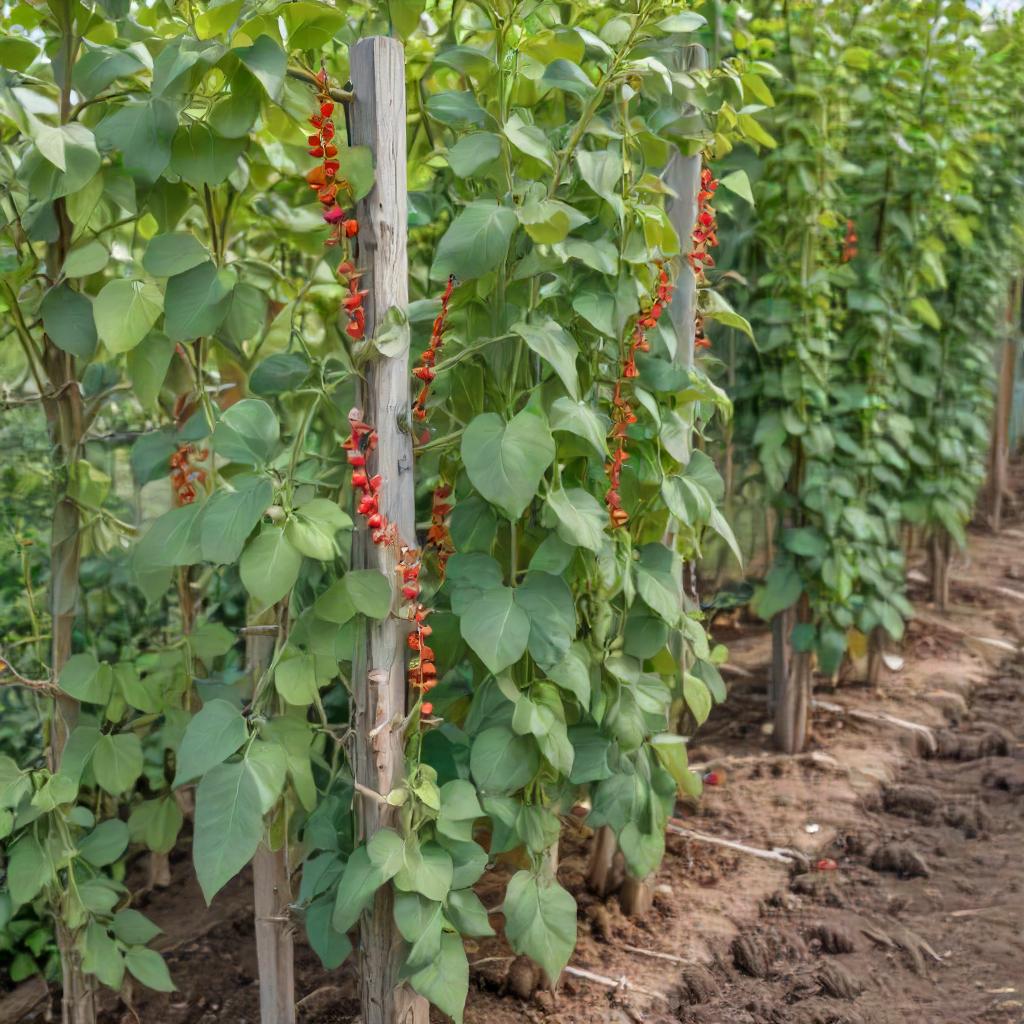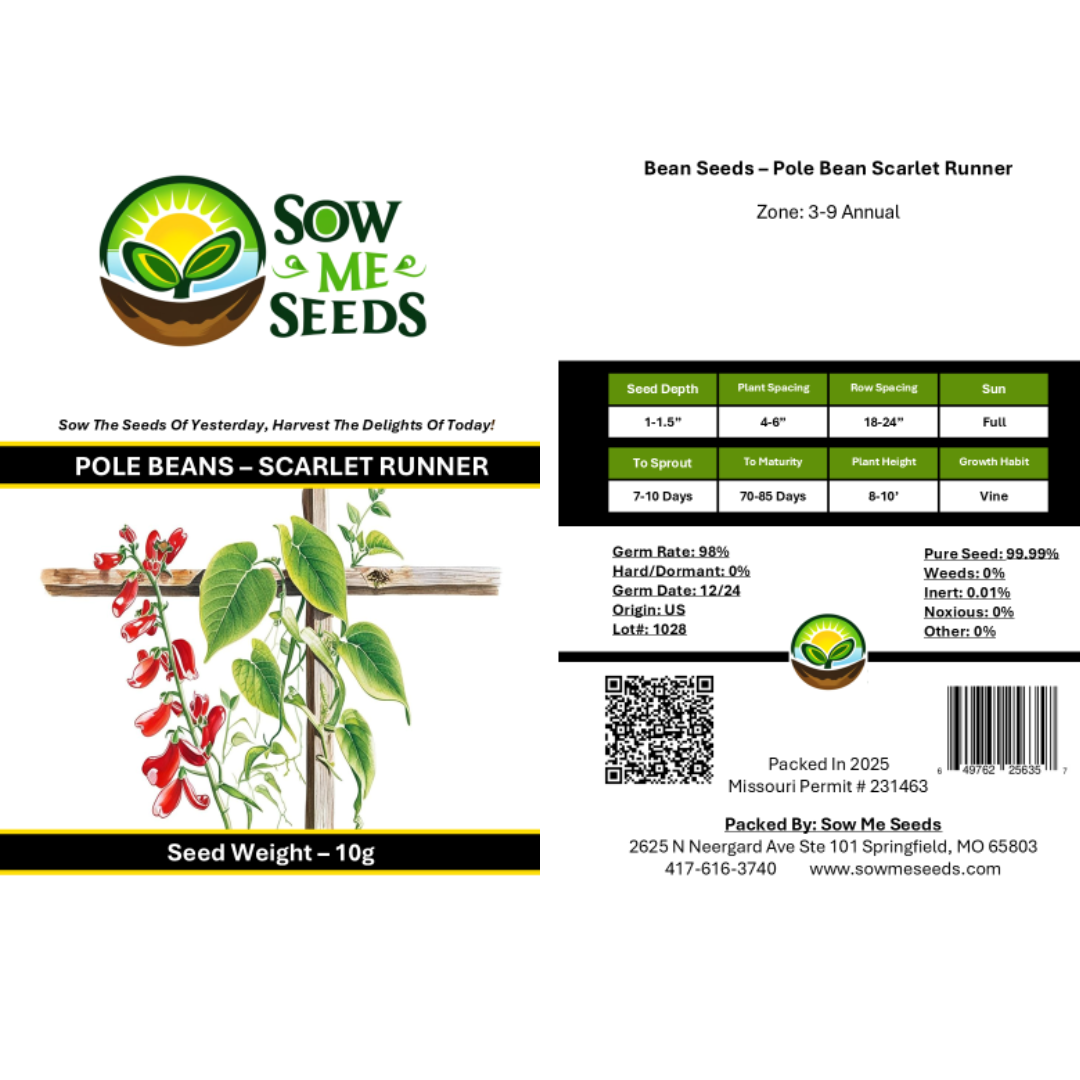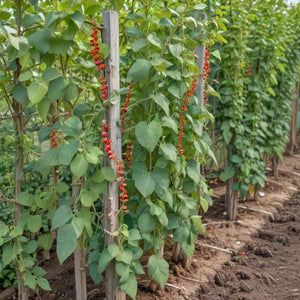- Hardiness Zone: 3-9 Annual
Seed Depth: 1–1.5 inches
Seed Spacing: 6 inches
Row Spacing: 24 inches
Sunlight: Full sun
Days to Sprout: 7–14 days
Days to Maturity: 65–75 days
Growth Habit: Vining
Sunlight: Requires full sun for vigorous growth, with at least 6–8 hours daily.
Soil Type: Prefers well-drained, fertile soil with a pH of 6.0–7.0.
When to Plant: Sow seeds outdoors after the last frost, when soil temperatures are above 50°F.
Direct Sowing: Plant seeds 1–1.5 inches deep, spacing them 6 inches apart, with rows 24 inches apart. Provide a sturdy trellis or support system for climbing.
Indoor Sowing: Start seeds 2–3 weeks before the last frost for an early start and transplant carefully to avoid disturbing roots.
Succession Planting: Not typically necessary, as these vigorous plants produce over an extended period.
Watering: Keep soil evenly moist but avoid waterlogging. Deep watering promotes strong root systems.
Fertilizing: Use a low-nitrogen fertilizer to encourage pod production instead of excessive foliage.
Pruning: No pruning necessary; train vines to climb supports for optimal growth.
Pest and Disease Control: Monitor for aphids, bean beetles, and fungal diseases; treat with organic solutions as needed.
When to Harvest: Pick young pods when they are tender and 4–6 inches long for fresh use. For seeds, allow pods to fully mature and dry on the vine.
How to Harvest: Gently pull pods from vines to avoid damaging the plant.
Seed Collection: Allow pods to dry completely on the plant before collecting seeds.
Storing Seeds: Store seeds in an airtight container in a cool, dry place for replanting or culinary use.
Why You’ll Love It
Dual-Purpose Plant: Beautiful enough for flower beds, productive enough for the vegetable garden.
Bright Red Blooms: Eye-catching scarlet flowers attract hummingbirds, bees, and butterflies.
Long Pods: Tender when young and flavorful when shelled at maturity — can be used fresh or dried.
Fast-Growing Vines: Perfect for trellises, fences, and arbors — adds vertical interest to any garden space.
Plant Characteristics
Height: 8–10 feet or more (requires strong support)
Growth Habit: Vigorous, twining vines with large leaves and showy blooms
Pod Type: Long green pods, 6–10 inches, with large mottled seeds inside
Days to Maturity: 70–85 days
Hardiness: Warm-season annual (perennial in frost-free zones)
Flavor and Culinary Uses
Flavor: Young pods are tender with a mild, nutty flavor; mature beans are rich and meaty
Culinary Uses: Enjoy young pods steamed or sautéed; use mature beans in soups, stews, or dried for storage
Companion Planting Tips
Good Companions: Corn, squash, and nasturtiums
Avoid Planting Near: Fennel and onions
Bonus Benefit: Provides shade for other crops and creates a habitat for pollinators and beneficial insects
Common Issues and Solutions
Tough Pods: Harvest young for best texture — older pods can be shelled or left to dry for storage
Aphids or Japanese Beetles: Spray with water or neem oil, and encourage natural predators like ladybugs
Overcrowding: Space vines properly and provide sturdy vertical support to prevent tangling
Seeds Per Packet
| 10g | Approximately 10 |
| 20g | Approximately 20 |
Why You’ll Love It
Dual-Purpose Plant: Beautiful enough for flower beds, productive enough for the vegetable garden.
Bright Red Blooms: Eye-catching scarlet flowers attract hummingbirds, bees, and butterflies.
Long Pods: Tender when young and flavorful when shelled at maturity — can be used fresh or dried.
Fast-Growing Vines: Perfect for trellises, fences, and arbors — adds vertical interest to any garden space.
Plant Characteristics
Height: 8–10 feet or more (requires strong support)
Growth Habit: Vigorous, twining vines with large leaves and showy blooms
Pod Type: Long green pods, 6–10 inches, with large mottled seeds inside
Days to Maturity: 70–85 days
Hardiness: Warm-season annual (perennial in frost-free zones)
Flavor and Culinary Uses
Flavor: Young pods are tender with a mild, nutty flavor; mature beans are rich and meaty
Culinary Uses: Enjoy young pods steamed or sautéed; use mature beans in soups, stews, or dried for storage
Companion Planting Tips
Good Companions: Corn, squash, and nasturtiums
Avoid Planting Near: Fennel and onions
Bonus Benefit: Provides shade for other crops and creates a habitat for pollinators and beneficial insects
Common Issues and Solutions
Tough Pods: Harvest young for best texture — older pods can be shelled or left to dry for storage
Aphids or Japanese Beetles: Spray with water or neem oil, and encourage natural predators like ladybugs
Overcrowding: Space vines properly and provide sturdy vertical support to prevent tangling
Seeds Per Packet
| 10g | Approximately 10 |
| 20g | Approximately 20 |





Share and get 15% off!
Simply share this product on one of the following social networks and you will unlock 15% off!